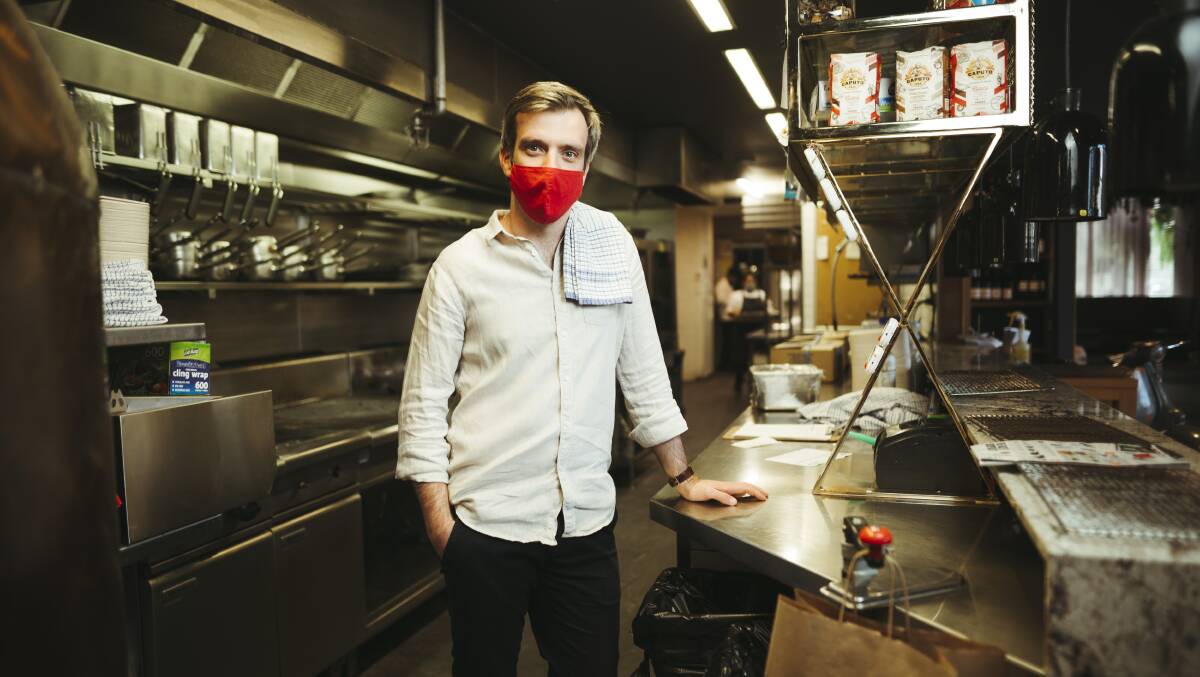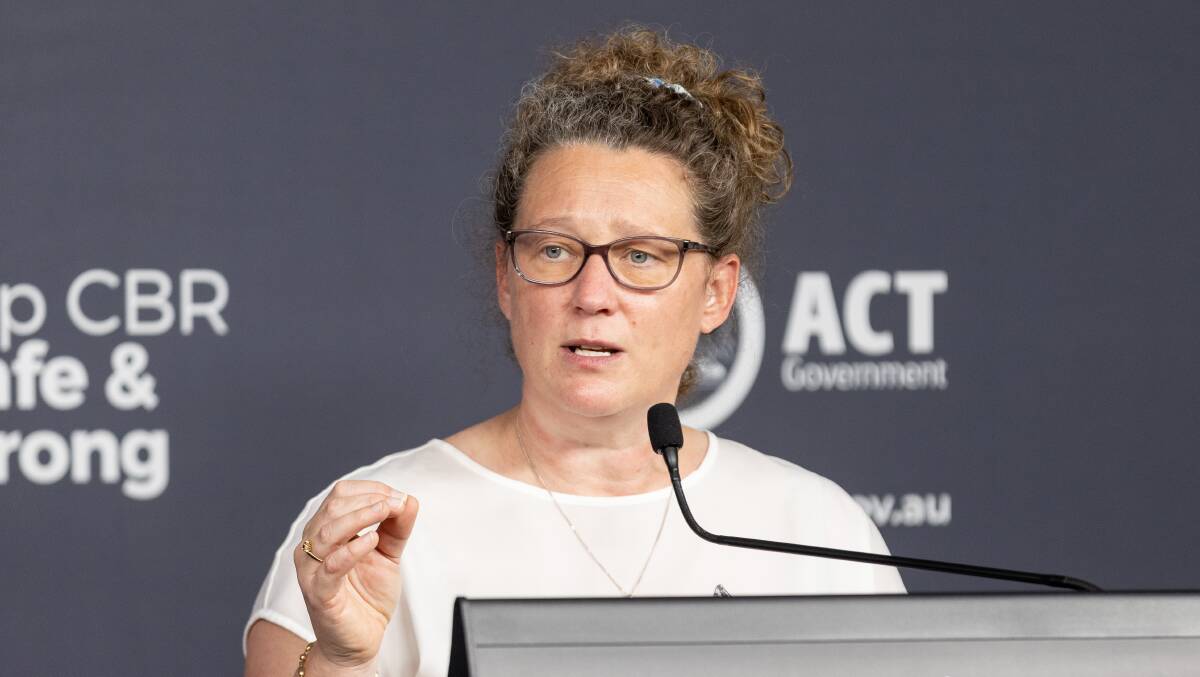A peak ACT hospitality body is disappointed in the changes to contact tracing rules, saying restaurants and cafes would struggle to operate while a two-week quarantine period was still in effect. Under changes to contact tracing rules, to come into place on Friday, businesses will not necessarily be forced to close if visited by a COVID-positive person. It would mean venues visited for a short period by a COVID-positive customer or “non-staff-member”, including takeaway cafes and restaurants and click-and-collect retail, would be considered low-risk and generally not listed as exposure sites. In an announcement reflecting the territory’s high vaccination uptake, ACT chief health officer Kerryn Coleman revealed housemates of close contacts will also no longer need to quarantine from Friday. When it comes to contact tracing efforts, there will be a shift away from trying to determine the movements of each positive case to instead focusing on locations where transmission is most likely. The move will mean businesses will not always close if visited by a COVID-positive person. Dr Coleman said the question of whether an entire venue would have to close would depend on a range of factors, including the venue’s adherence to COVID-19 guidelines. ACT Health will also stop listing exposure sites where people are told to monitor for symptoms. But no changes have been made to the length of time that people are required to quarantine when they are identified as close contacts of a positive case, with 14 days’ isolation still required. This has put the hospitality industry on edge, as restaurants and cafes are at high risk of being considered close-contact exposure sites. Australian Hotels Association ACT general manager Anthony Brierley said venues would not want to open under these requirements. He was also critical of the timing of the changes, saying they should have been released last week to give venues the option to decide whether to open or not. Mr Brierley said he would not be surprised if a venue opened only to rid itself of stock it had ordered and then closed again until there was a further easing of restrictions. “Our understanding at the moment [is] that the nature of hospitality venues is likely to see them classified as a close-contact location, and then all the patrons and staff are probably going to have to quarantine for 14 days,” he said. “That means a business simply will not have employees to be able to open. “Hospitality businesses can’t afford to run two separate teams.” Dr Coleman said many factors played a role in how hospitality venues were assessed. “For a pub or for a restaurant or some situation like that, we will continue to conduct our rigorous public health risk assessment,” she said. “And there are many factors which come into play around that: who is the case, what protective behaviours were they displaying, how close were they to other people [and] how much movement was there in that location.” NSW has changed its isolation requirements for fully vaccinated people, who now only need to isolate for seven days if they are deemed a close contact. Mr Brierley called on the ACT to follow suit. Further changes to quarantine have been flagged by October 29. MORE COVID-19 NEWS: ACT authorities are also hoping to avoid massive numbers of people going into quarantine. At the peak of this latest outbreak, there were more than 20,000 close contacts in quarantine in the ACT. Dr Coleman said she hoped those numbers would not be reached again, but could not rule it out. “These changes today, and some of the changes that we’ll be looking at into the future, are about really focusing our efforts on those people who are most likely to become a case,” Dr Coleman said. “We know that we’re not going to be able to stop all transmission, we want to stop the transmission that is most likely to occur, and where it’s going to occur in those places where it’s going to have a big impact.” The ACT has yet to identify any changes to exposure settings for schools. “We’re still working through that one at the moment,” Dr Coleman said. “Any changes that we make here today are about low-risk settings and don’t apply to those high-risk settings such as schools. “We can have more to say about that as we get closer to more students going back.” Our coverage of the health and safety aspects of this outbreak of COVID-19 in the ACT and the lockdown is free for anyone to access. However, we depend on subscription revenue to support our journalism. If you are able, please subscribe here. If you are already a subscriber, thank you for your support. You can also sign up for our newsletters for regular updates. Our journalists work hard to provide local, up-to-date news to the community. This is how you can continue to access our trusted content:
Fears for hospitality after contact tracing changes disappoint
/images/transform/v1/crop/frm/79652520/099956db-5346-40bf-a50d-b130bbfb7ab6.jpg/r3_256_4998_3078_w1200_h678_fmax.jpg
Under changes to contact tracing rules businesses will not necessarily be forced to close if visited by a COVID-positive person.
news, business,
2021-10-14T05:30:00+11:00
https://players.brightcove.net/3879528182001/default_default/index.html?videoId=6276831082001
https://players.brightcove.net/3879528182001/default_default/index.html?videoId=6276831082001
A peak ACT hospitality body is disappointed in the changes to contact tracing rules, saying restaurants and cafes would struggle to operate while a two-week quarantine period was still in effect.
It would mean venues visited for a short period by a COVID-positive customer or “non-staff-member”, including takeaway cafes and restaurants and click-and-collect retail, would be considered low-risk and generally not listed as exposure sites.
In an announcement reflecting the territory’s high vaccination uptake, ACT chief health officer Kerryn Coleman revealed housemates of close contacts will also no longer need to quarantine from Friday.
When it comes to contact tracing efforts, there will be a shift away from trying to determine the movements of each positive case to instead focusing on locations where transmission is most likely.
AHA ACT general manager Anthony Brierley. Picture: Dion Georgopoulos
The move will mean businesses will not always close if visited by a COVID-positive person. Dr Coleman said the question of whether an entire venue would have to close would depend on a range of factors, including the venue’s adherence to COVID-19 guidelines.
ACT Health will also stop listing exposure sites where people are told to monitor for symptoms.
But no changes have been made to the length of time that people are required to quarantine when they are identified as close contacts of a positive case, with 14 days’ isolation still required.
This has put the hospitality industry on edge, as restaurants and cafes are at high risk of being considered close-contact exposure sites.
ACT chief health officer Dr Kerryn Coleman. Picture: Sitthixay Ditthavong
He was also critical of the timing of the changes, saying they should have been released last week to give venues the option to decide whether to open or not.
Mr Brierley said he would not be surprised if a venue opened only to rid itself of stock it had ordered and then closed again until there was a further easing of restrictions.
“Our understanding at the moment [is] that the nature of hospitality venues is likely to see them classified as a close-contact location, and then all the patrons and staff are probably going to have to quarantine for 14 days,” he said.
“That means a business simply will not have employees to be able to open.
“Hospitality businesses can’t afford to run two separate teams.”
Dr Coleman said many factors played a role in how hospitality venues were assessed.
“For a pub or for a restaurant or some situation like that, we will continue to conduct our rigorous public health risk assessment,” she said.
“And there are many factors which come into play around that: who is the case, what protective behaviours were they displaying, how close were they to other people [and] how much movement was there in that location.”
NSW has changed its isolation requirements for fully vaccinated people, who now only need to isolate for seven days if they are deemed a close contact.
Mr Brierley called on the ACT to follow suit.
ACT authorities are also hoping to avoid massive numbers of people going into quarantine.
At the peak of this latest outbreak, there were more than 20,000 close contacts in quarantine in the ACT. Dr Coleman said she hoped those numbers would not be reached again, but could not rule it out.
“These changes today, and some of the changes that we’ll be looking at into the future, are about really focusing our efforts on those people who are most likely to become a case,” Dr Coleman said.
“We know that we’re not going to be able to stop all transmission, we want to stop the transmission that is most likely to occur, and where it’s going to occur in those places where it’s going to have a big impact.”
The ACT has yet to identify any changes to exposure settings for schools.
“We’re still working through that one at the moment,” Dr Coleman said.
“Any changes that we make here today are about low-risk settings and don’t apply to those high-risk settings such as schools.
“We can have more to say about that as we get closer to more students going back.”
Our coverage of the health and safety aspects of this outbreak of COVID-19 in the ACT and the lockdown is free for anyone to access. However, we depend on subscription revenue to support our journalism. If you are able, please subscribe here. If you are already a subscriber, thank you for your support. You can also sign up for our newsletters for regular updates.
Our journalists work hard to provide local, up-to-date news to the community. This is how you can continue to access our trusted content:
© The Canberra Times
Views: 7

